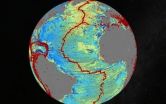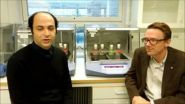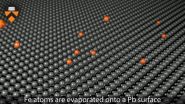Researchers discover gene that can predict aggressive prostate cancer at diagnosis
Study identified a genetic variant near the KLK3 gene that could stratify GS7 prostate cancer patients
2014-10-02
(Press-News.org) Researchers at The University of Texas MD Anderson Cancer Center have identified a biomarker living next door to the KLK3 gene that can predict which GS7 prostate cancer patients will have a more aggressive form of cancer.
The results reported in the journal of Clinical Cancer Research, a publication of the American Association of Cancer Research, indicate the KLK3 gene – a gene on chromosome 19 responsible for encoding the prostate-specific antigen (PSA) – is not only associated with prostate cancer aggression, but a single nucleotide polymorphism (SNP) on it is more apparent in cancer patients with GS7.
Researchers have linked Gleason score, an important predictor of prostate cancer outcomes, to several clinical end points, including clinical stage, cancer aggression and survival. There has been much research associated with prostate cancer outcomes as well as GS7 prostate cancers, which is an intermediate grade of cancer accounting for 30 to 40 percent of all prostate cancers.
"This is the first report that I am aware of that indicates a genetic variant can stratify GS7 prostate cancer patients," said Jian Gu, Ph.D., associate professor at MD Anderson, and a key investigator on the study. "This is important because this group with heterogeneous prognosis is difficult to predict and there are no reliable biomarkers to stratify this group."
In this study, researchers investigated inherited genetic variants to see if there would be any promising biomarkers for prostate cancer patients. The investigators studied the genetic makeup of 72 SNPs identified from the genome-wide association studies (GWAS) in 1,827 prostate cancer patients. They analyzed associations of these SNPs with disease aggression, comparing them in clinically defined high and low aggressive cases. They found a SNP on the KLK3 gene that can predict an aggressive form of GS7 disease.
"Treatment options for the GS7 disease are controversial because the burden of combined treatment modalities may outweigh the potential benefit in some patients," said Xifeng Wu, M.D., Ph.D., professor and chair of Epidemiology, and lead investigator on the study. "It is critical that we develop personalized treatments based on additional biomarkers to stratify GS7 prostate cancers. Additional biomarkers may help us achieve personalized clinical management of low and intermediate risk prostate cancer patients."
Wu also said her team are expanding the study and taking a pathway-based approach to systemically investigate genetic variants in microRNA regulatory pathways as biomarkers for the prognosis of prostate cancer patients. "We are also working on circulating biomarkers. Eventually, we will incorporate all biomarkers, epidemiological and clinical variants into nomograms to best predict the prognosis of prostate cancer patients at diagnosis."
INFORMATION:
Other MD Anderson co-authors include Yonggang He, M.D., Ph.D. and Sara Strom, Ph.D., of Epidemiology; Christopher Logothetis, M.D. and Jeri Kim, M.D., of Genitourinary Medical Oncology
The study was funded by the National Cancer Institute (CA140388) and MD Anderson Cancer Center institutional support for the Prostate Cancer Moon Shots Program and the Center for Translational and Public Health Genomics.
[Attachments] See images for this press release:

ELSE PRESS RELEASES FROM THIS DATE:
2014-10-02
Scientists have created a new map of the world's seafloor, offering a more vivid picture of the structures that make up the deepest, least-explored parts of the ocean.
The feat was accomplished by accessing two untapped streams of satellite data.
Thousands of previously uncharted mountains rising from the seafloor, called seamounts, have emerged through the map, along with new clues about the formation of the continents.
Combined with existing data and improved remote sensing instruments, the map, described today in the journal Science, gives scientists new tools ...
2014-10-02
Zoonosis—transmission of infections from other vertebrates to humans—causes regular and sometimes serious disease outbreaks. Bats are a well-known vertebrate reservoir of viruses like rabies and Ebola. Recent discovery of sequences in bats that are resemble influenza virus genes raised the question of whether bat flu viruses exist and could pose a threat to humans. A study published on October 2nd in PLOS Pathogens addresses this question based on detailed molecular and virological characterization.
Because no infectious virus particles were isolated from the bat samples ...
2014-10-02
Scientists at the University of California, Santa Cruz, using a new wildlife tracking collar they developed, were able to continuously monitor the movements of mountain lions in the wild and determine how much energy the big cats use to stalk, pounce, and overpower their prey.
The research team's findings, published October 3 in Science, help explain why most cats use a "stalk and pounce" hunting strategy. The new "SMART" wildlife collar--equipped with GPS, accelerometers, and other high-tech features--tells researchers not just where an animal is but what it is doing ...
2014-10-02
VIDEO:
This is a video interview with Jens Nielsen.
With a simple mutation, yeast can grow in higher than normal temperatures. Researchers at Chalmers University of Technology demonstrate this in an article...
Click here for more information.
With a simple mutation, yeast can grow in higher than normal temperatures. Researchers at Chalmers University of Technology demonstrate this in an article to be published in the scientific journal Science. The findings may result in ethanol ...
2014-10-02
Wild cheetah populations have declined precipitously in the past century: from an estimated 100,000 in 1900 to only around 10,000 today. A new study from researchers in Europe, South Africa and at North Carolina State University suggests that the energy cheetahs spend looking for prey, rather than their high-speed hunting tactics or food stolen by other predators, may be to blame for their dwindling numbers.
Cheetahs are high-speed hunters, but are not the strongest predators in their ecosystems. Often, hyenas and lions will take advantage of this, stealing the cheetah's ...
2014-10-02
VIDEO:
Princeton University researchers first deposited iron atoms onto a lead surface to create an atomically thin wire. They then used a scanning-tunneling microscope to create a magnetic field and to...
Click here for more information.
Princeton University scientists have observed an exotic particle that behaves simultaneously like matter and antimatter, a feat of math and engineering that could yield powerful computers based on quantum mechanics.
Using a two-story-tall microscope ...
2014-10-02
The HIV pandemic with us today is almost certain to have begun its global spread from Kinshasa, the capital of the Democratic Republic of the Congo (DRC), according to a new study.
An international team, led by Oxford University and University of Leuven scientists, has reconstructed the genetic history of the HIV-1 group M pandemic, the event that saw HIV spread across the African continent and around the world, and concluded that it originated in Kinshasa. The team's analysis suggests that the common ancestor of group M is highly likely to have emerged in Kinshasa around ...
2014-10-02
Accessing two previously untapped streams of satellite data, scientists at Scripps Institution of Oceanography at UC San Diego and their colleagues have created a new map of the world's seafloor, creating a much more vivid picture of the structures that make up the deepest, least-explored parts of the ocean. Thousands of previously uncharted mountains rising from the seafloor and new clues about the formation of the continents have emerged through the new map, which is twice as accurate as the previous version produced nearly 20 years ago.
Developed using a scientific ...
2014-10-02
A new study led by Queen's University Belfast into how cheetahs burn energy suggests that human activity, rather than larger predators, may force them to expend more energy and thus be the major cause of their decline.
Wild cheetahs are down to under 10,000 from 100,000 a century ago with conventional wisdom blaming bigger predators for monopolising available food as their habitat becomes restricted. The traditional thinking has been that cheetahs no longer have sufficient access to prey to fuel their enormous energy output when engaging in super-fast chases.
But, ...
2014-10-02
CAMBRIDGE, MA -- Yeast are commonly used to transform corn and other plant materials into biofuels such as ethanol. However, large concentrations of ethanol can be toxic to yeast, which has limited the production capacity of many yeast strains used in industry.
"Toxicity is probably the single most important problem in cost-effective biofuels production," says Gregory Stephanopoulos, the Willard Henry Dow Professor of Chemical Engineering at MIT.
Now Stephanopoulos and colleagues at MIT and the Whitehead Institute for Biomedical Research have identified a new way to ...
LAST 30 PRESS RELEASES:
[Press-News.org] Researchers discover gene that can predict aggressive prostate cancer at diagnosis
Study identified a genetic variant near the KLK3 gene that could stratify GS7 prostate cancer patients





